#añute
Text



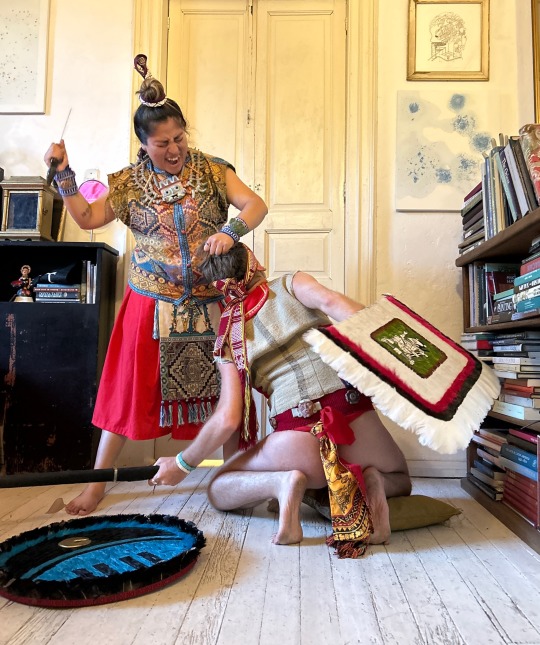
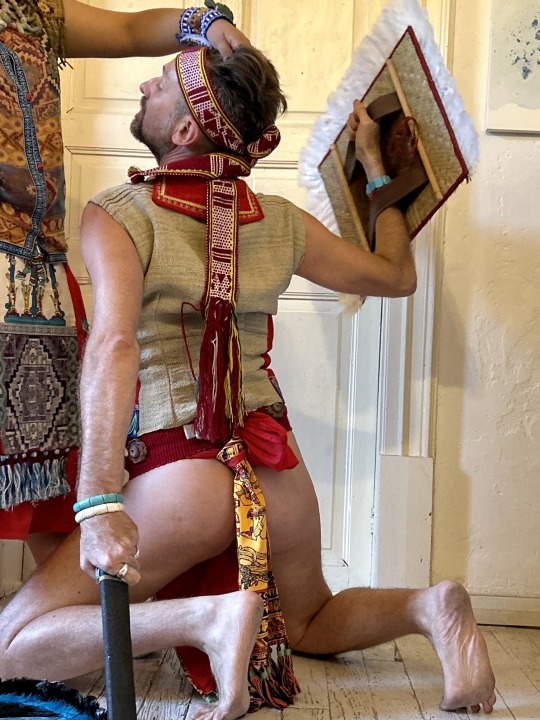





This is a painting of Iño Codzo, Lady Six Monkey, a warrior ruler of the Ñuu Dzahui or Mixtec culture, who lived in the 11th century of our era. In the Codex Añute, it is told how she was engaged to Lord Eleven Wind, and on the way to her wedding she was offended by Lord Two Alligator and Lord Six Lizard, the rulers of the Mountain of the Insect and the Mountain of the Moon. After consulting with Lady Nine Grass, the oracle of Our Mother the Earth, Lady Six Monkey attacked and conquered the Mountain of the Insect and the Mountain of the Moon, capturing Lord Two Alligator and Lord Six Lizard.
Because of her bravery and her ability, she was presented with a quechquemitl or "blouse" painted with the glyph of war. This symbol became part of her name, and thus she was known as Lady Six Monkey War Blouse.
In my painting, she appears in battle, wearing a woman's skirt but also a man's loincloth, symbolizing her role as both a feminine and a masculine figure, a yya dzehe toniñe or "queen", and a warrior. She captures Lord Two Alligator, who can be seen kneeling before her.
You can find prints of Lady Six Monkey in my Etsy store!
137 notes
·
View notes
Text

Some people like Lord 8-Deer Jaguar Claw.
I like Lady 6-Monkey War Quechquemitl.
37 notes
·
View notes
Text
ArchaeoLit: Mesoamerican codices
Now that the semester is over and I am no longer drowning in student papers, it’s time to get back into research that might be considered a bit more fun. The Mesoamerican codex re-entangled. Production, Use, and Re-use of Precolonial Documents is the Ph.D. dissertation of Ludo Snijders at the University of Leiden. Ludo was instrumental in the writing of my MA thesis: checking my theoretical arguments, lending me books from his library, and pointing out the flaws in my research he knew my supervisor would critique. His research focuses primarily on the physicality of the codices, as evidenced by these excerpts from his abstract here below:
This work is an attempt to piece together the cultural biography of the precolonial Mesoamerican codices. It will be shown that modern technology is capable of elucidating even the earliest episodes of this biography. The less than twenty manuscripts that still exist today are all that remains of the Mesoamerican book-making tradition. Past studies of these pictographic and hieroglyphic manuscripts have focussed mostly on their content. The lack of a focus on their physical characteristics has meant that not enough is known about the production, use and re-use of these books.
Almost all books that have survived the colonial period did so within the walls of European institutions. For many of these books it is not well known how they got there, or where they came from. For some it was even forgotten that they came from the Americas. In these institutes the books lost their meaning and the workings of the writings system were forgotten. It was only with their reproduction that they could be studied and started to regain someof their meaning. The strategies of reproduction can be considered as a new chapter in the cultural biography of these codices. The different ways of reproduction transformed the objects in fundamental ways. Inaccurate reproduction is one obvious transformation, but even photographic reproduction, with its two-dimensionality, changes the codex. A second aspect of transformation is the creation of access to these books through reproduction. Whom they are reproduced for is as important as how they are reproduced. Reproduction of these books has given more access to scholars, but has due to the costs of many of the reproductions had a limited impact on the general public.
You may even have seen Ludo’s work in Science and other popular websites, discussing the previous writing he and his team uncovered beneath the Codex Selden. The Mesoamerican codices are clearly dear to my heart (I did write my MA thesis on them) but even if it is not your specialization, it provides a fascinating look at the transformative journey of these manuscripts over time. Check it out here for some light 200 pg. bedtime reading.
#mesoamerican codices#ludo snijders#mesoamerican writing#mesoamerican archaeology#archaeolit#codex selden#writing#writing systems#university of leiden#Codex Añute#codices#codex
30 notes
·
View notes
Text
Scientists Discover First American Palimpsest
Everyone recycles! Even pre-Columbian Mixtec. The Codex Selden, also known as the Codex Añute, dates from the mid-1500s and is a five-meter-long strip of deer hide covered in glyphs and human figures. It is one of fewer than 20 known Mexican codices to have survived from pre-colonial and early colonial Mexico. And it is the first known pre-Columbian palimpsest!
What's that you ask? It means the deer hide once had a different document on it, which was scraped off, so the parchment could be reused for what we know today as the Codex Añute. Thankfully the scrapping was imperfect, allowing modern-day scientists to uncover the traces of imagery that remain. That's all we know right now. Tests are currently being conducted to reconstruct what was written or drawn, and to try and figure out what it meant.
219 notes
·
View notes
Photo
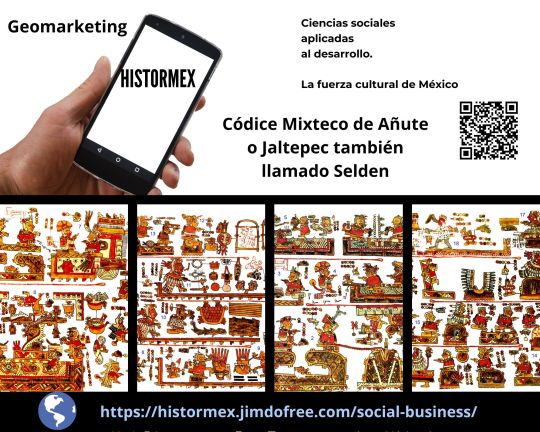
Taller de Códices Mesoaméricanos Códice Añute, Jaltepec o Selden
0 notes
Text
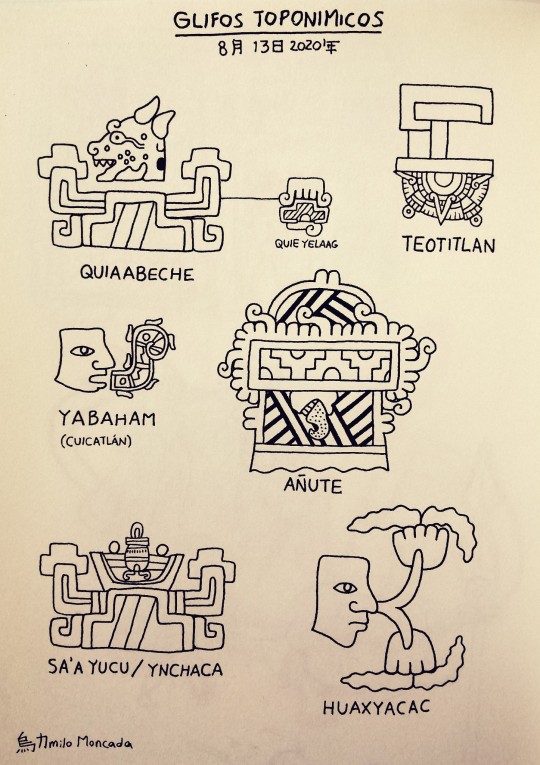
Toponymic glyphs I drew yesterday for Codex Black. All but Sa'a Yucu and Quie Yelaag are the actual glyphs used to represent those places, and among these Quie Yelaag is the only fictional place.
#CodexBlack#CodiceNegro#Webcomic#toponymic#glyph#glyphs#Mesoamerica#Mexico#Oaxaca#Ozolotepec#Teotitlan#Cuicatlan#Xaltepec#Añute#Cuilapan#Coyolapan#Sa'a Yucu#Huaxyacac#Aztec#Zapotec#Mixtec#Cuicatec
76 notes
·
View notes
Photo
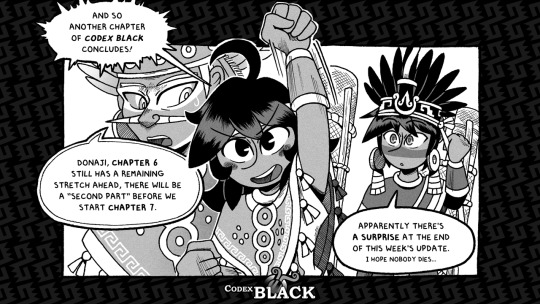
It’s webcomic Thursday!
Chapter 6, pages 42-45 now online.
Donaji & Itzcacalotl depart towards the Mixtec city of Añute! Heads up for a “surprise” at the end of this update!
English
- Codex Black on Tapas
- Codex Black on Tumblr
Español
- Códice Negro en Tapas
- Códice Negro en Tumblr
#CodexBlack#CodiceNegro#webcomic#update#aztec#zapotec#prehispanic#mesoamerica#mexico#oaxaca#mitla#historical#historical fiction#historical fantasy#original characters#donaji#itzcacalotl#oracle
15 notes
·
View notes
Photo


Lady Ñuñuu Dzico-Yecu (”6-Monkey War Quexquemitl”), Mixtec princess of Añute and later queen of the Añute-Huachino alliance. Born in 1073 CE, she played a mayor role in shaping the political landscape and the power structures of the Mixteca. Died sacrificed by her enemies in 1100 CE (her son would avenge her years later though).
Her life is truly fascinating, I would really like to do a comic about her someday if I ever get the chance.
Here’s a great article about her in case you want to learn more: Lady Six Monkey: The Great Warrior Queen of the Mixtecs
#mixtec#mixteca#añute#jaltepec#six monkey#warrior#princess#queen#mesoamerica#mexico#oaxaca#historical
58 notes
·
View notes